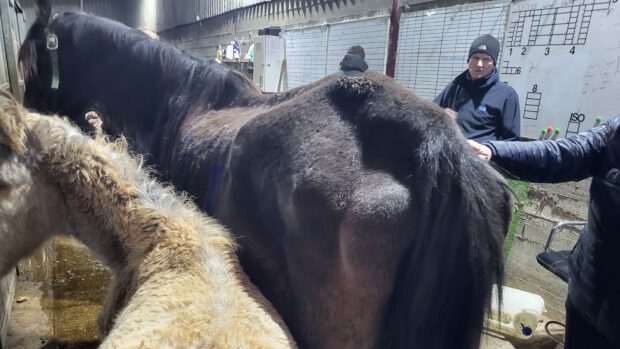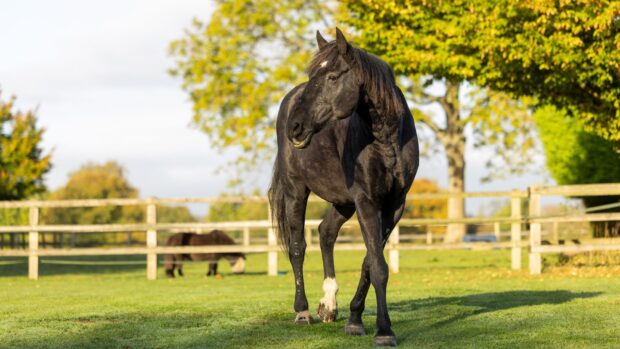Some of the first people on the scene at Spindles Farm have looked back on the horrific events 10 years since the crisis.
On 4 January 2008, the RSPCA, police and trading standards entered the now infamous farm in Amersham, Buckinghamshire, and started one of the largest ever equine rescues in the UK.
Katie Robinson was the first vet on site.
“It was a Friday afternoon and the RSCPA had reported that there was a dead horse there and they needed a vet,” Katie told H&H.
She added that the police and RSPCA were already there when she arrived.
“As I drove up the lane, there were police in the driveway, they flagged me down and said ‘it is much worse than anybody thought’.”
Katie was joined by two more vets and between them and the RSPCA the team identified between 17 and 20 horses who needed to be removed immediately.
As evening drew in, the Horse Trust was contacted and agreed to take these horses.
“We knew we had to get them out that night because they were in such a terrible state,” she said.
Katie added when she arrived the “job took over” and it was only afterwards that she was able to process the magnitude of the situation.
Katie called the knacker man to put down two horses whose suffering was too great to help and he also took away some of the bodies of horses that had already died.
The rescuers were on site until midnight and many of the same people were back the next morning to continue.
“Because I didn’t know what I was going to, I didn’t have time to get worried about it,” said Katie, adding the RSPCA was “amazing”.
‘Haunted by the memories’
Spindles Farm 10 Years On | RSPCA
Ten years later, Inspector Kirsty Withnail reflects on her first impressions of the heartbreaking investigation at Spindles Farm. An incredible multi-agency operation meant that a total of 111 horses, ponies and donkeys were rescued, and those who survived are now living the lives they deserve: http://bit.ly/2nC9mnA
Posted by RSPCA (England & Wales) on Friday, February 2, 2018
Kirsty Withnall was the first RSPCA inspector on site.
“What I remember most about those first moments after I walked into the farmyard was the complete silence,” she said.
“Reports stated that there were almost 100 horses being kept there, but we could hear nothing.
“No neighing or whinnying or ‘chaos’ that you’d expect with so many horses altogether in one place — the silence was very unsettling.
“Peering over broken gates and fences in the dingy barn, we had no idea what awful sights we’d be seeing next.
“Frightened ponies crammed together into tiny stables was shocking enough, but in one pen, I could even see the bodies of two horses sinking knee-deep into the filthy ground underneath all the clambering hooves.”
She added the smell was the next thing to hit them.
“Decomposing bodies of horses, stables that hadn’t been mucked out in months and months, and the smell of infection coming from so many of the ponies who were still alive,” added Kirsty.
“Among the dead horses and the pile of bones we had to step over, we could see so many faces looking back at us.
“[These were] horses who were still hanging on and just about surviving, so we knew we would have to plough on through the horror and focus on getting to every single one of these poor ponies, and bring them to safety.”
A total of 111 horses, ponies and donkeys were taken from the farm over the following four days in a joint rescue operation involving many charities.
“It still makes me incredibly sad to think of those 32 horses who weren’t so lucky and didn’t survive long enough to see the day of the rescue,” said Kirsty.
“I’m haunted by the memories of that day, 10 years ago, but the stories of those ponies who survived and are today living the lives they deserve and are very loved and appreciated, are what helps me overcome the horror I saw and makes my job so worthwhile.”
Article continues below…
You might also be interested in:

Redwings releases 250 ‘horses’ in memory of Spindles Farm
Money raised through the sale of the ponies will be put towards caring for equine survivors of the 2008 Amersham

10 years on: remembering the horrors of Spindles Farm
Redwings Horse Sanctuary is holding commemorative events in 2018 in memory of the equines who tragically lost their lives and
‘Unprecedented scale’
The team at the Horse Trust worked “around the clock” to care for the sick animals it had taken in at a moment’s notice and the others it took over the following days.
“The horror and unprecedented scale of the neglect and suffering at Spindles Farm was a dark day but from it came a something of a new dawn,” said a Horse Trust spokesman.
“The joint operation between the agencies and charities involved heralded a new level of co-operation.
“[It also] paved the way for a national equine health and welfare strategy, an Equine Sector Council for health and welfare and very soon, a combined, cross-sector group that brings together equine related industries, elite sport, racing and breeding as well as vets, leisure riding, teaching, enforcement agencies and of course, welfare charities.”
Horse Trust chief executive Jeanette Allen added the charity is still home to five of the rescued horses, and has three others out on loan.
“Sadly, whilst this was the biggest equine rescue seen in the UK there are still thousands of horses, ponies and donkeys suffering or in danger of suffering, due to irresponsible owning and breeding,” said Jeanette.
“There is still more work to be done and the Horse Trust will continue to play its part along with colleague charities across the country.”
For all the latest news analysis, competition reports, interviews, features and much more, don’t miss Horse & Hound magazine, on sale every Thursday




